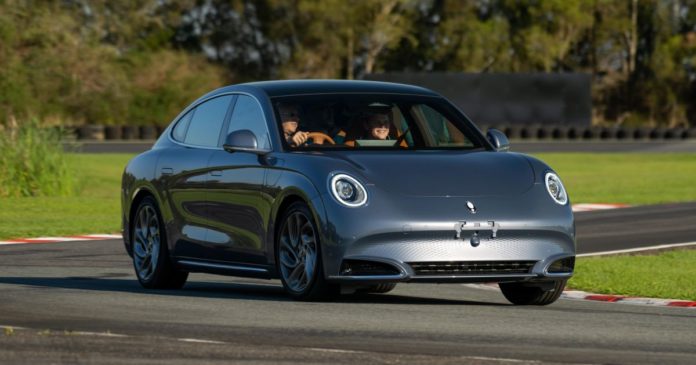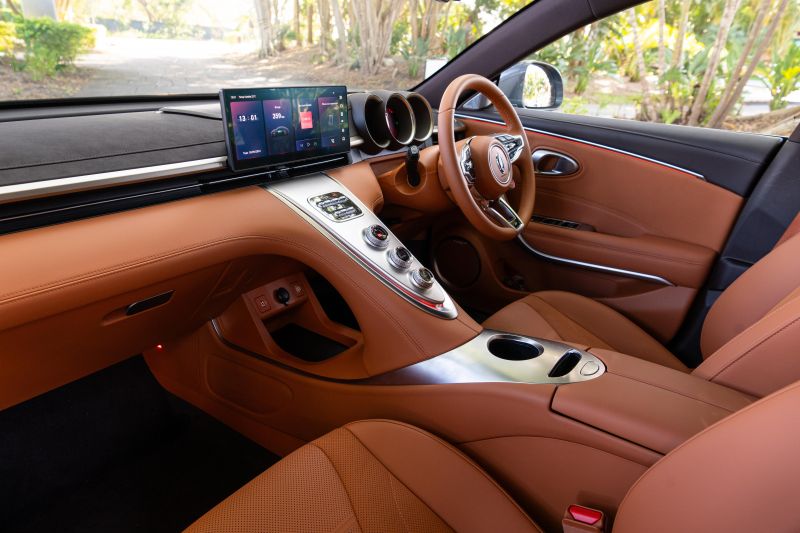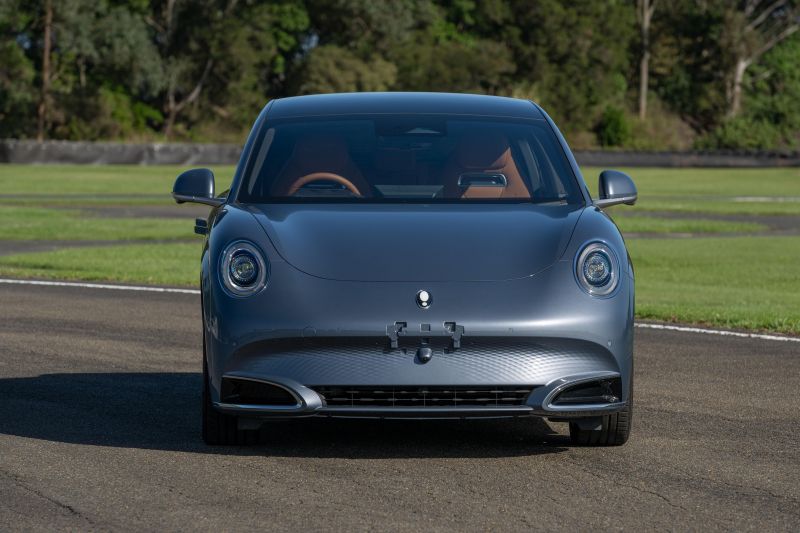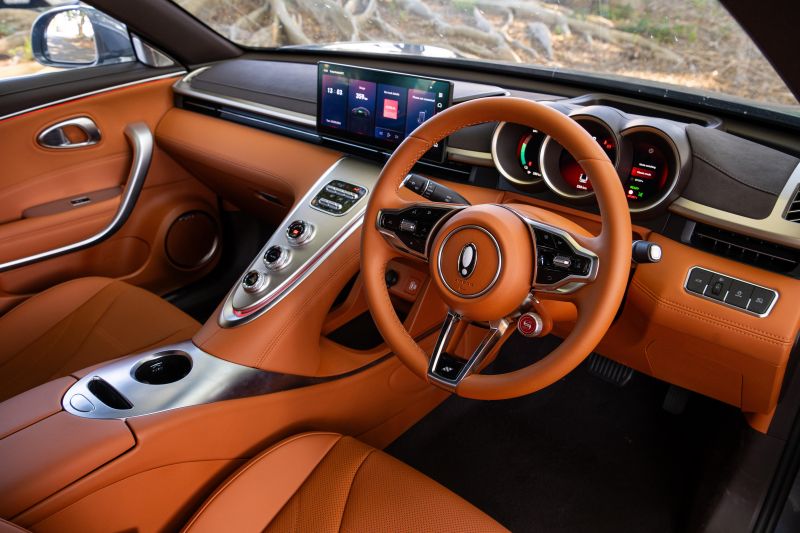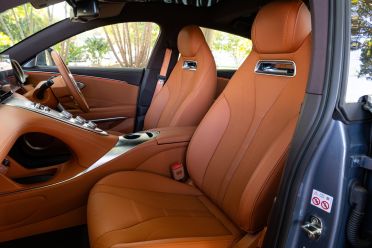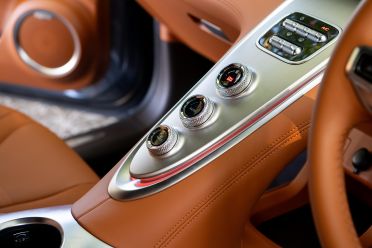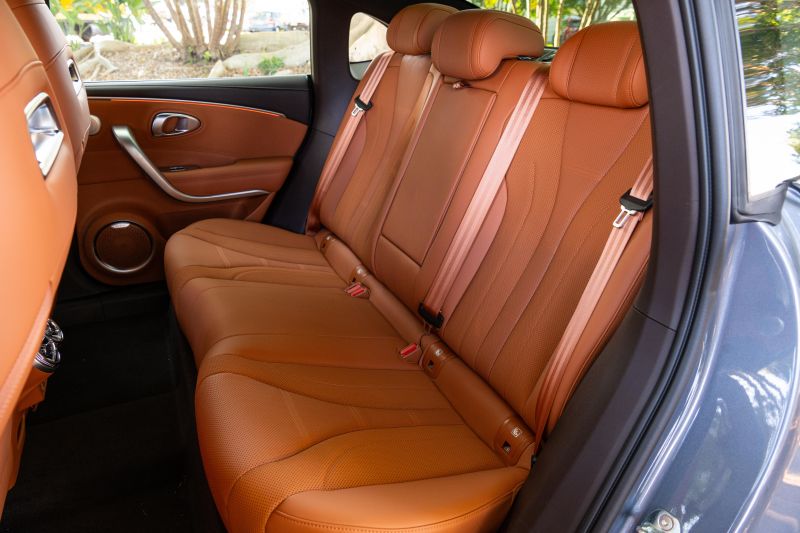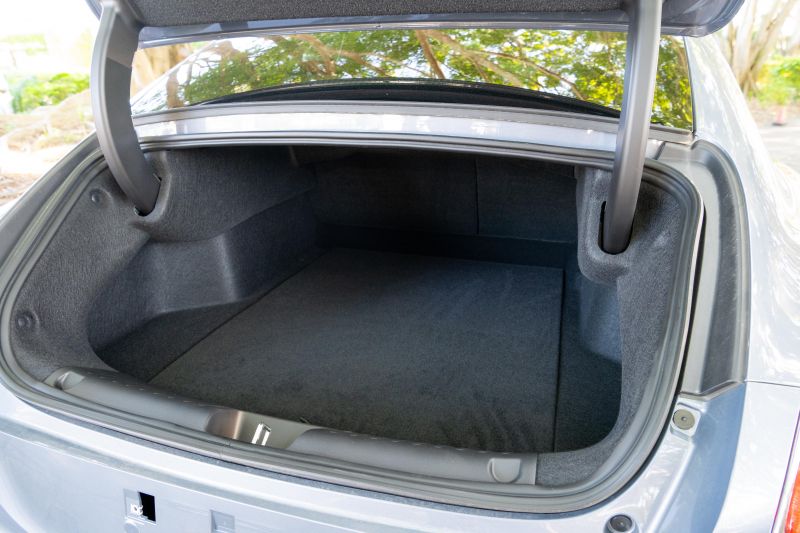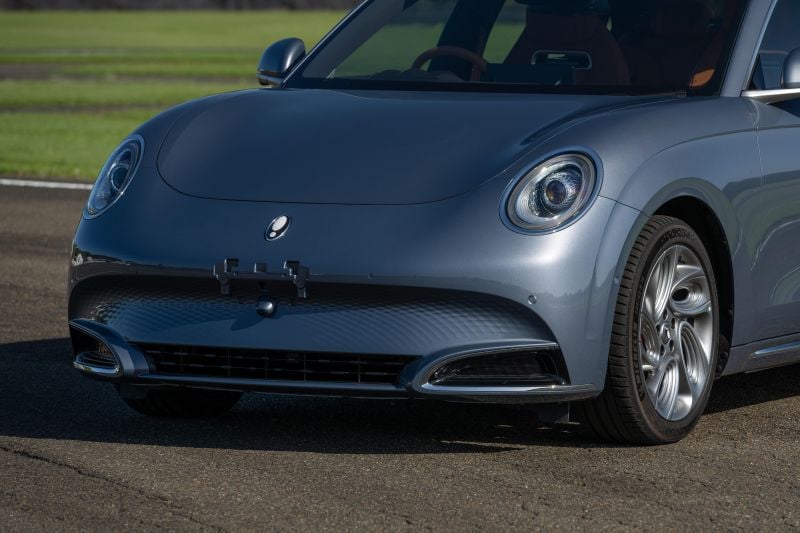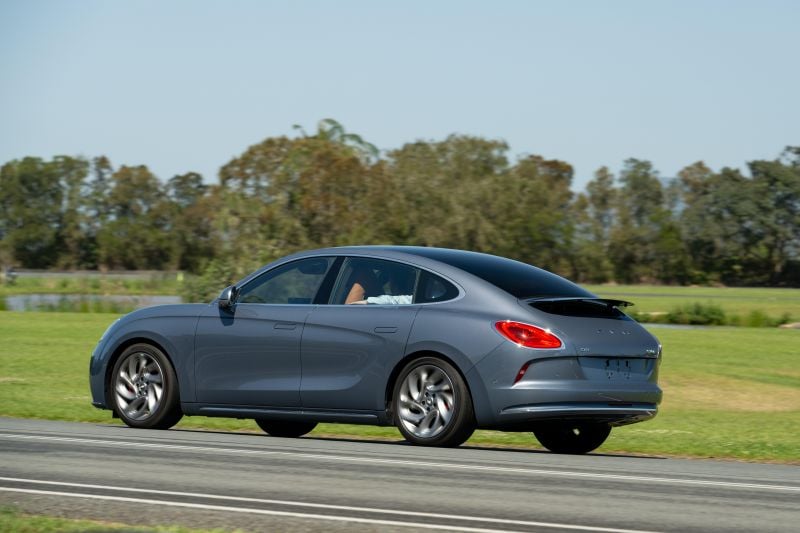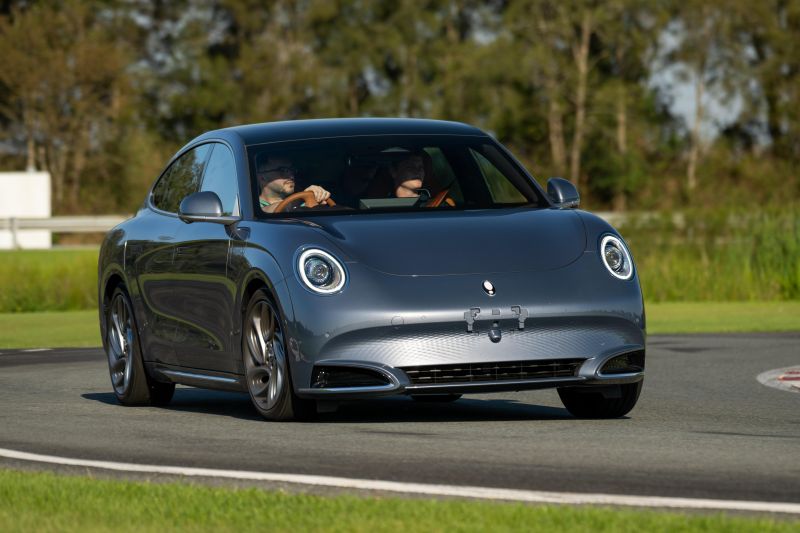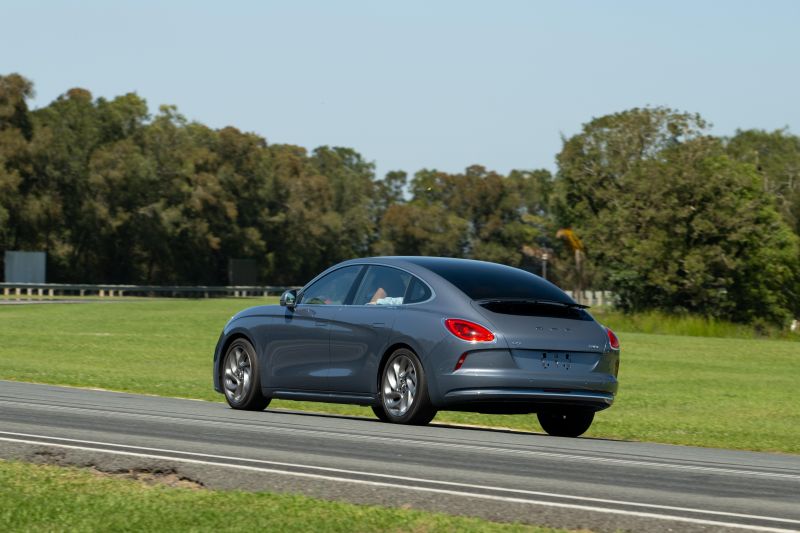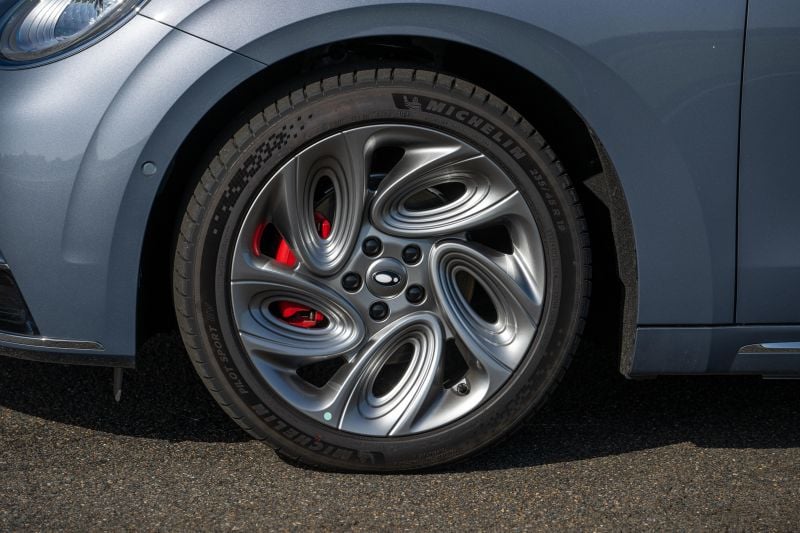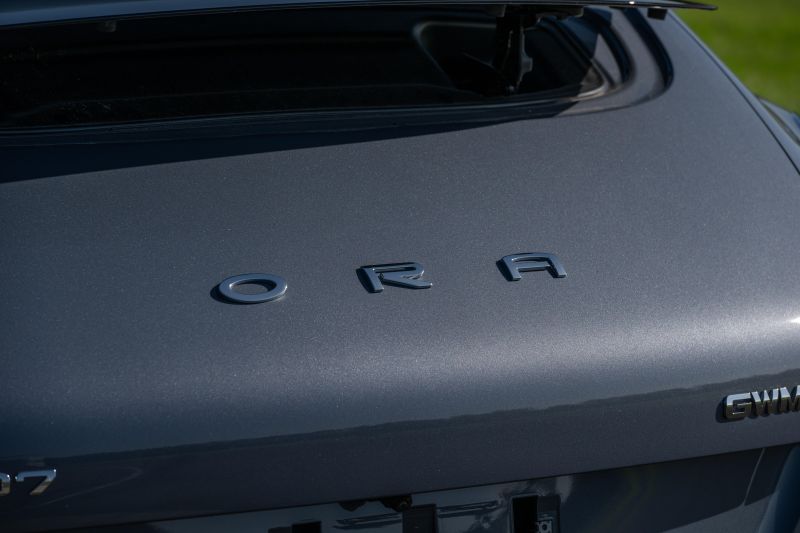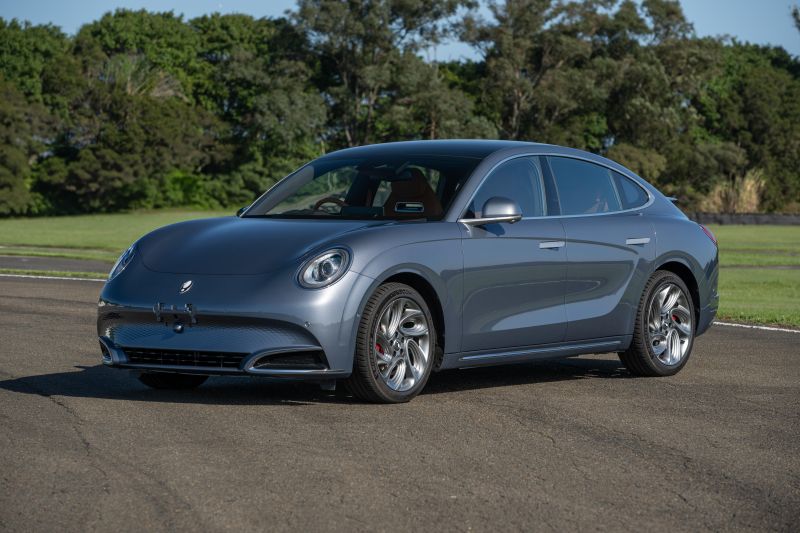We first tested the GWM Ora Sport way back in February 2023, and it hasn’t appeared in local showrooms since.
At the time, right-hand drive wasn’t available, and now it is – and GWM says the unusually styled sedan is now “more of a serious consideration”.
While we drove a single-motor front-wheel drive model back then, this time we were given the opportunity to drive a dual-motor all-wheel drive version.
Known in China as the Lightning Cat, this curvaceous sedan is the closest thing GWM has to a Tesla Model 3 rival. Measuring 4871mm long, 1862mm wide and 1500mm tall on a 2870mm wheelbase, the Ora Sport is 151mm longer than a Model 3 but 71mm narrower. It also sits on a 5mm longer wheelbase.
It’s slippery, too, with a drag coefficient of just 0.22.
It’s sold via the standalone Ora brand in China, one of a quintet of brands Great Wall Motor runs which also includes GWM, Haval, Tank and Wey. In contrast, all Great Wall Motor vehicles are sold in Australia under a single overarching brand, GWM.
Ora’s Good Cat – also known as the Funky Cat (cute!) or 03 (boring!), depending on the market – is currently the sole Ora model sold here, confusingly, as the Ora.
GWM for now is calling this the Ora Sport for our market, though notably our Malaysian-market tester wears Ora 07 badging.
While Lightning Cat is perhaps too whimsical a name for our market, Ora Sport is arguably inviting confusion with the top-spec Ora GT.
How does the GWM Ora Sport compare?
View a detailed breakdown of the GWM Ora Sport against similarly sized vehicles.

GWM
Ora Sport
How much does the GWM Ora Sport cost?
We don’t know how much the Ora Sport will cost.
The Ora hatchback is currently priced from $35,990 to $43,990 drive-away.
If GWM brings the Ora Sport here, we suspect it will want to keep it fairly close to models like the Tesla Model 3 and BYD Seal. The base versions of these, featuring a single electric motor, start at $54,900 and $49,888 before on-road costs, respectively.
What is the GWM Ora Sport like on the inside?
Styling is subjective, and I’ll admit the exterior styling is not at all to my taste despite the hints of Bentley Continental and Porsche Panamera.
The interior, however, is much more appealing to my eyes and I feel it’ll be less polarising to consumers.
Less polarising, but no less distinctive. Just take a look at that floating centre console! Not only does it look cool, but it has knurled dials for things like fan speed and temperature adjustment.
With so many Chinese cars moving even the simplest of switchgear functions to touchscreens, having actual physical dials – plus some neat metallic switches further up the console – is very refreshing.
Of course, there’s a large 12.3-inch touchscreen, while what look like three analogue dials are also digital screens.
The last Ora Sport we drove had an off-white interior, but the rich tan of our dual-motor model really elevates the ambience. This interior looks expensive.
Material quality is quite good, with the dashboard and centre console finished in soft-touch trim with stitching details.
Practicality is so-so, though. There’s a huge space under the centre console large enough for a handbag, but there’s only one cupholder.
Rear legroom is superb, and the floor is largely flat. Headroom is tight, however. At 180cm tall, my head was brushing against the roof.
The back seat is a pretty cool place, from a style if perhaps not a temperature point of view.
The rear window extends up to halfway along the roof, effectively serving as one big panoramic glass roof for rear-seat occupants. There’s a beam ahead of this on which map lights sit, and then there’s another glass panel ahead of the front seats.
We do wonder how this would feel on a hot summer’s day parked out of the shade, as there’s no sun blind. GWM claims the glass is rated to SPF 100 however, blocking out 99.9 per cent of UV rays and 95 per cent of infrared.
There are a couple of funky circular air vents in the rear, as well as a USB-A outlet, USB-C outlet and map pockets on the front seat backs.
It wouldn’t be a Chinese car without a squishy but ultimately comfortable rear bench.
GWM didn’t skimp on materials back here. While some cars switch to hard plastic for the rear door cards, the tops of the Ora Sport’s doors are still finished in soft-touch trim.
The boot opening is somewhat small. This is a conventional sedan like a Model 3 or Seal, and not a liftback like a Polestar 2. GWM didn’t provide a cargo capacity figure.
| Dimensions | GWM Ora Sport |
|---|---|
| Length | 4871mm |
| Width | 1862mm |
| Height | 1500mm |
| Wheelbase | 2870mm |
What’s under the bonnet?
| Specifications | GWM Ora Sport |
|---|---|
| Drivetrain | Dual-motor electric |
| Battery | 83.49kWh ternary lithium |
| Power | 300kW |
| Torque | 680Nm |
| Driven wheels | All-wheel drive |
| Weight | 2115kg |
| 0-100km/h (claimed) | 4.3 seconds |
| Power consumption (claimed) | 15.5kWh/100km (NEDC) |
| Claimed range | 550km (NEDC) |
| Max DC charge rate | 88kW |
| Max AC charge rate | 11kW |
That 550km range figure is on the more lenient NEDC cycle, while a Tesla Model 3 Long Range AWD has 629km on the stricter WLTP cycle.
The Ora Sport features vehicle-to-load (V2L) capability, allowing you to power external appliances. Output is 3.3kW.
How does the GWM Ora Sport drive?
Before we got behind the wheel, GWM took us through some key details.
Notably, company executives referred to the Ora Sport as having suspension tuning “with an emphasis placed on comfort” and called it a “comfortable grand tourer”.
Based on this verbiage I thought this car was going to feel very soft and floaty. But GWM also referred to it as a sport sedan, and let us take it around the track at Norwell Motorplex. There were some mixed signals here…
Granted, the car wasn’t road registered so we couldn’t exactly drive it anywhere else, but still it seemed like the company was standing behind the vehicle having some dynamic ability.
To GWM’s credit, the Ora proved quite enjoyable on our brief drive around Norwell.
We did a few laps in Normal and Sport modes, before testing out Sport+. This most extreme of the drive modes loosens the reins on the electronic nannies… and is all the worse for it.
When pushed, it feels like there’s too much power for the GWM to effectively put down to the pavement even with its grippy Michelin Pilot Sport EV tyres.
Fortunately, in Normal and Sport modes it was much more pleasant. Toggling between these drive modes adjusts things like the steering and responsiveness of the vehicle. The difference in steering weight between drive modes, for example, was palpable – we liked the heft in Sport mode.
Even in Normal mode, the Ora Sport is plenty quick. It pumps out 300kW of power and 680Nm of torque, and has a claimed 0-100km/h time of 4.3 seconds – that’s 0.1 seconds quicker than a Tesla Model 3 Long Range.
The Ora Sport stays impressively flat in the corners, with body roll well controlled. In more aggressive driving, however, we found the spongy brake pedal irksome.
There’s a deployable rear spoiler that can generate up to 20kg of downforce, which GWM says can improve traction during braking and cornering.
We hardly think anybody in the market for an Ora Sport is giving serious thought to downforce, nor do we think anybody is going to take one of these to the track. But hey, cute feature.
While a couple of laps around the track gave us a general feeling of the Ora Sport’s competence, we’d like to spend more time with the vehicle. We also have no gauge on ride comfort, as a smooth track is hardly representative of typical Australian road conditions.
The Ora Sport rides on MacPherson strut front suspension and multi-link rear suspension.
At highway speeds, we found its cabin to be impressively quiet, but again this was on a smooth surface.
Speaking of noise, you can choose between three propulsion sounds. One of these simulates a combustion-powered vehicle, and divided opinion among those who drove it – personally, I rather enjoyed it.
There may have been disagreement about artificial propulsion sounds in EVs being silly or not, but we found agreement on the absolutely goofy transition sounds that play when you toggle between drive modes in the Ora Sport.
What do you get?
We don’t know what the local Ora Sport lineup could look like, but in China it’s offered in a range of trim levels.
The dual-motor version sits atop the range, and comes standard with:
- 19-inch alloy wheels in Michelin Pilot Sport EV tyres
- Intelligent torque distribution system
- Semi-automatic parking assist
- Rear privacy glass
- Rain-sensing wipers
- Panoramic sunroof
- Hands-free power boot lid
- Automatic LED headlights
- Proximity entry with push-button start
- 6-way power driver’s seat with memory
- 4-way power passenger seat
- Heated front seats
- Ventilated front seats (cushion only)
- Massaging front seats (seat back only)
- Heated rear seats
- Leather upholstery
- Heated steering wheel
- 10.25-inch digital instrument cluster
- 12.3-inch touchscreen infotainment system
- Head-up display
- Wireless phone charger
- 11-speaker sound system
- Ambient interior lighting
- Dual-zone climate control
- Intelligent fragrance system with three fragrances
- Heat pump
GWM in China also says the Ora Sport comes with several cryptically named features such as Warm Man Mode, Kids Mode, Cave Time, Goddess Mode and Ride The Waves Mode.
It doesn’t explain these features on its Chinese website, but we know what some of these features entail based on a previous announcement GWM made about the Ballet Cat electric hatch.
In that model, Ride the Wind and Waves mode is designed to be activated in case of sudden rain or snow. Press the button and the windows are closed, the air-conditioning turned on, and the adaptive cruise control, lights and wipers are adjusted.
Goddess Mode is understood to be a lighter setting for the electric power-assisted steering, while Kids Mode plays nursery rhymes for your baby in the back seat.
The amusingly named Warm Man Mode turns on the driver’s heated seat and steering wheel and adjusts the air-conditioning. As for what Cave Time does, we’re unclear. This may have been lost in translation…
Is the GWM Ora Sport safe?
The Ora Sport has yet to be tested by ANCAP or Euro NCAP.
GWM boasts it performed an industry-first rollover crash test that simulated an Ora Sport flying off a bridge. It reached a maximum height of over six metres, rolled five times, and stopped around 40m from the flipping ramp.
Available safety equipment includes:
- Adaptive cruise control
- Autonomous emergency braking
- Blind-spot monitoring
- Driver attention monitoring
- Intelligent Cruise Assist
- Emergency lane-keep assist
- Lane-keep assist
- Front cross-traffic assist
- Rear cross-traffic assist
- Safe exit warning
- Surround-view camera with transparent chassis mode
- Front and rear parking sensors
- Traffic Jam Assist
- Traffic sign recognition
How much does the GWM Ora Sport cost to run?
GWM backs all its vehicles in Australia with a seven-year, unlimited-kilometre warranty, while the Ora EV has an eight-year, unlimited-kilometre warranty for its high-voltage battery.
We’d expect the Ora Sport to offer the same, though whether it’ll match the Ora hatch in terms of service pricing remains to be seen. The small EV’s first five services are capped at just $99 each.
CarExpert’s Take on the GWM Ora Sport
The GWM Ora Sport’s styling is bound to put some buyers off, much as the smaller Ora hatchback’s design has deterred buyers.
Locally, the Ora is outsold 2-to-1 by the BYD Dolphin and more than 4-to-1 by the MG 4 despite being quite competitive with both of them. That’s a shame, as both it and the Ora Sport have plenty to offer.
The Ora Sport’s controversial body does sacrifice some interior practicality for style, but the cabin is a surprisingly upscale environment with a dashing design and some lovely materials.
While we didn’t get to drive the Ora Sport out on the road, on the track it proved smooth, quiet and powerful, with balanced handling.
GWM appears to still be gauging whether there’s demand for the Ora Sport locally. So, what do you think? Should GWM introduce it, and would you take one over a Model 3?
Click the images for the full gallery
MORE: Everything GWM Ora Sport

